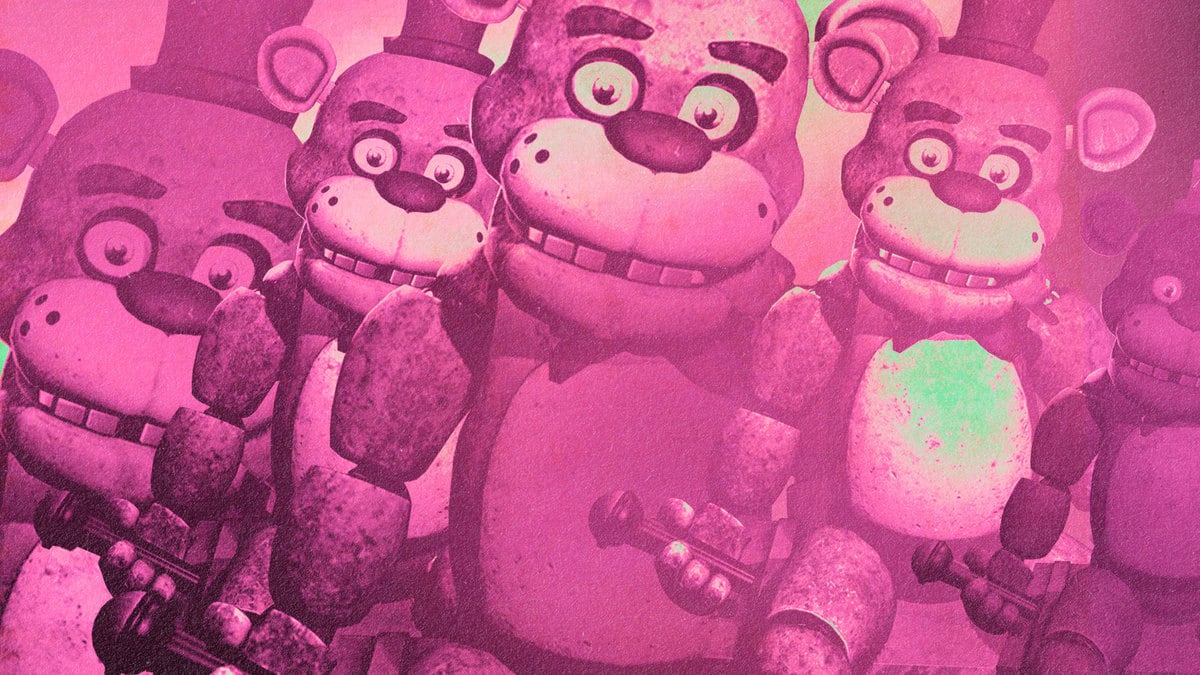In August 2014, when independent developer Scott Cawthon released Five Nights at Freddy’s, the video game seemed almost ingeniously simple. The game was set in a Chuck E. Cheese’s-type pizza-tainment center, and you played a security guard working the night shift. Your task was to make sure the murderous animatronics that started walking around at night didn’t kill you, but the only way to protect yourself was by monitoring the cameras in the control room so you know just when to lock the doors. Fail to do that, and you’ll have a giant robot bear or bunny up in your face, filling the screen.
Surviving this once was daunting. Surviving it five times? Yeah, good luck.
And thus, a phenomenon was born. Streamers played the game to rapt audiences, filming themselves screeching at every jump scare. Older players saw Freddy’s as a test of courage preying on their nostalgic nightmares of those horrible animatronic singing animals. Younger players saw it as a tantalizingly, deliriously creepy take on the play-place birthday parties they still attended. Freddy’s became a cross-generation success story, the kind that the media loves to cover and players love to celebrate.

From 2014 onward, Cawthon became a huge name in the gaming space. He released numerous sequels in rapid succession, selling tens of millions of copies. Just as quickly as there was a game at all, there were spinoff novels. There was merch. There was fan art and fan games. There was a movie deal, which only came to fruition this year, six years after it entered development. (Five Nights at Freddy’s is now in theaters and streaming on Peacock.) And there was even explosive controversy, with Cawthon bowing out of game design entirely in response to outcry over his political donations—yes, Five Nights at Freddy’s got big enough to have a political scandal.
That’s a lot for a little computer game made by just one person to go through. And to outsiders, perhaps it seems unlikely that something whose appeal seems this basic—nostalgia bait, but make it creepy—would generate this much fervor. In fact, unless you are a parent or big into video games, Freddy’s is probably not anywhere near your radar.
But for millions of people, Five Nights at Freddy’s is an important part of their lives. And, in turn, the series owes everything to its fandom, which has weathered the loss of its creator and helped the games blossom into something much bigger than anyone could have imagined. And what’s most telling about Freddy’s longevity is that there isn’t one thing in particular that’s kept fans so attached to the series. Its appeal is myriad, multifarious, and expressed in fascinatingly, delightfully online ways.
To get a broader sense of why—and how!—Five Nights at Freddy’s has developed such a special fanbase, I reached out to the people who know best: the fanbase. I certainly can’t claim to have the definitive picture of this fandom based on speaking with a smattering of players. But what I found most interesting was that each one cited a different entry point into the franchise, from finding themselves intrigued by cosplay they saw at conventions, to discovering it through wildly popular, unofficial songs.
Jonathan Hanscom is a fan based on the East Coast whose social media accounts offer horror game news, particularly Freddy’s. He’s been a fan for as long as the series has been around. “I was introduced to the series by a close friend shortly after the release of the first game in 2014,” he said. “The first title does such a spectacular job of supplying just enough information for casual players while also hiding plenty of secrets to hook players into sticking around. I think that’s why the franchise has lasted for as long as it has.”
“You’ll be hard-pressed to find a fandom as dedicated as the FNAF community,” Hanscom added, and he would know; his Twitter page has more than 70,000 followers looking to him for Freddy’s updates.
Freddy’s fans have developed something of a reputation for being very, very invested with the franchise—which is almost a requirement, considering how quickly the nine main games were released and how many novels and in-game secrets there are.

In fact, for most of the Freddy’s fans I spoke to, the fandom was the initial appeal.
“I got into the series in early middle school due to my ‘boyfriend’ at the time,” Abigail, a longtime fan from Seattle, told me. “I have very distinct memories of typing on my keyboard phone and we talked about fan culture, which is how I found out he had a Tumblr.”
His Tumblr was laden with Freddy’s fan art, Abigail says—which immediately intrigued her. In particular, there was art of a mysterious character fans refer to as “Purple Guy,” a major figure in the series that fans endlessly reinterpret and discuss. (He’s also very creepy-looking, in a still-kid-appropriate way.)
“From there, I always kept an eye on the fandom and the content coming from it,” Abigail said. “But I didn’t so aggressively launch back into it until early high school, when watching Game Theory lore videos became my way of coping during finals season.”
Game Theory, also known as The Game Theorists, is a popular channel run by the YouTuber Matthew “MatPat” Patrick, whose work is dedicated to providing deep-dives into various series—and postulating bizarre theories. Some arguments made, which have racked up hundreds of millions of views across more than 600 videos, include: Link is dead; Mario is mentally ill; humans are Pokémon. In short, this is not the most accessible content for someone not already familiar with video game culture, and even then, it requires some suspension of disbelief. But for nine years, millions of viewers have turned to MatPat to ask the questions they didn’t even know they had about their favorite games.
MatPat is best known for his bountiful Freddy’s videos, which explore the various secrets, scares, and lore behind each game. Instead of focusing on the gameplay, MatPat explores Freddy’s wildly deep storyline, which requires vested interest to understand on even the simplest level. Through carefully placed clues and a slowly parceled-out overarching plot, Cawthon crafted an entire history behind Freddy Fazbear Pizzeria’s animatronics, and MatPat explores it. Ever since his first video about the first Freddy’s, which many fans credit with popularizing the game, he’s translated what the average player saw as nothing but a low-budget horror game with a reliably scary formula into something far deeper that makes players into diehard fans.
These videos, at their best, tap into the ironic appeal of Freddy’s, as MatPat himself explained in a recent interview with Vulture. “You could play through one of the early games of Five Nights at Freddy’s in about three hours,” he said. “But as you do it, you’d fixate on these small details… In Five Nights at Freddy’s, there are no coincidences. It felt like each of those details was an intentional choice leading you to a different part of the story.”
MatPat’s profession is both noble and incredibly difficult, to fans’ rapt amusement. “I love watching people try to make sense of the utterly confusing lore and come up with wild theories that connect everything together,” Montblanc, a Californian who has been playing the games since high school, told me. “That’s always a great part of any fandom—trying to predict stuff and put the story together while the story’s still ongoing—but this game series is particularly ripe for that.”
“Utterly confusing” and “wild” are great descriptors. I watched a 10-minute explainer of the lore, for example, while reporting this story. I came away with both too much knowledge and not enough; I can tell you that the story of Freddy’s spans several decades, heavily features the souls of dead children, and very much discourages you from ever going to a Chuck E. Cheese’s ever again.
Many streamers and YouTubers have capitalized on this… shall we say, complex lore over the years, to entertaining effect. Montblanc cites the various ways that these highly visible players engage with Freddy’s as part of the franchise’s and fandom’s appeal. “Content creators really boosted its popularity and continue to help keep the series afloat in a major way,” they said, naming YouTubers like MatPat, CoryxKenshin, and Dawko, who even scored an interview with Cawthon (pre-cancelation) in 2018. Many of these and other YouTubers were invited to visit the set of the film as well as attend its premiere; even the folks at Universal Pictures, the film’s distributor, understands how important they are to the franchise’s success.
But no one has been mentioned more to me than Mark “Markiplier” Fischbach. Markiplier’s wildly entertaining streams and playthroughs of the games over the years have garnered him 35 million YouTube subscribers and a mainstream audience. “A perfect example to me is Markiplier’s famous ‘IS THAT THE BITE OF ’87?’ clip. Mark being so excited about the lore and trying to piece things together was just so fun and meme-able.”
It may not be famous to you, but if you don’t laugh at that video, you’re lying. In one facial expression, Markiplier captures the at-times baffling, at-times fascinating world that Freddy’s has created. It’s easy to imagine a young, budding horror fan stumbling upon one of Markiplier’s streams and immediately wanting to check out everything this series has to offer—because why the hell is that 8-bit animatronic bear chomping on a child?!
Watching people like Markiplier play through the games while providing enthusiastic commentary is fun if you’ve already played Freddy’s yourself. But Abigail notes that it also helps folks who are intrigued by the lore and fan theories but don’t have the means or interest in playing the games to get involved. “I am not great at playing video games, so my primary way of consuming the story was through other people’s work, like Markiplier’s [playthroughs] and the reading of the FNAF fan wiki.”
Whether or not the games are actually as scary as streamers and YouTubers have often made them out to be, however, is debated. Even Hanscom has to admit that the game series is pretty silly. “You’ll find most of the frights and mature themes in the novels nowadays” instead, he says, calling it “a part of the franchise that’s geared more toward the hardcore fans of the lore.” That explains why one of the bigger fans I spoke to is 15, and has loved the series since they were 6 years old.

Yet the world of Freddy’s could seem intimidating, especially for a franchise that is popular with children and now has a Hollywood horror movie based on it. But for as many fans that really love digging through the many secrets of Purple Guy and the Afton family (to which Purple Guy belongs—go watch that explainer!), there are more that enjoy it for less-complicated reasons. “I think the series remains popular because of the timelessness of the concept,” Julia said. “Everyone’s a little afraid of mascot suits and inhuman robots, regardless of how old they are, so a whole game series based around that fear is something that appeals to just about everybody.”
Loving Freddy’s really can be boiled back down to that ingenious simplicity: Animatronic animals are creepy. You don’t need any amount of lore to tell you that.






